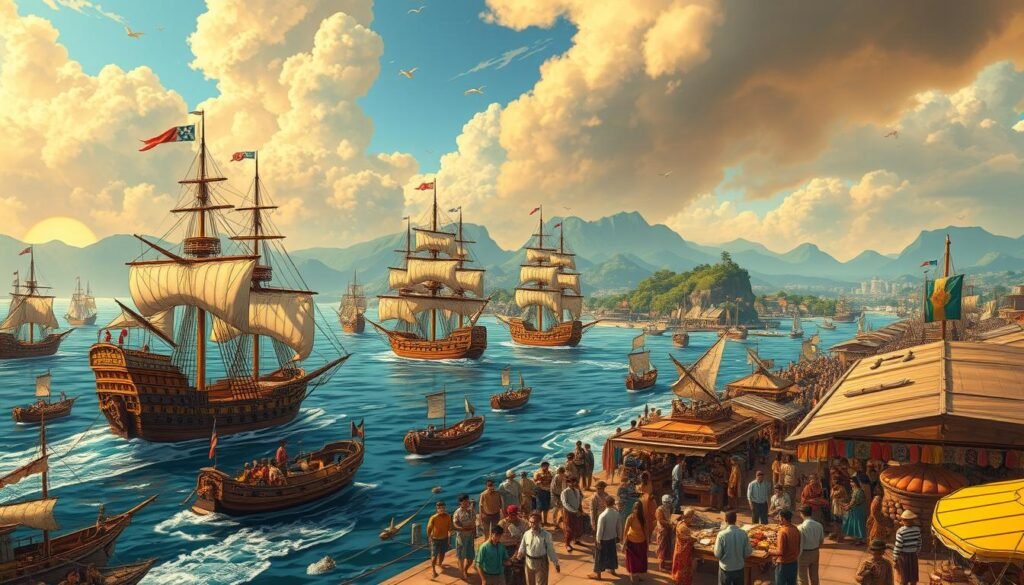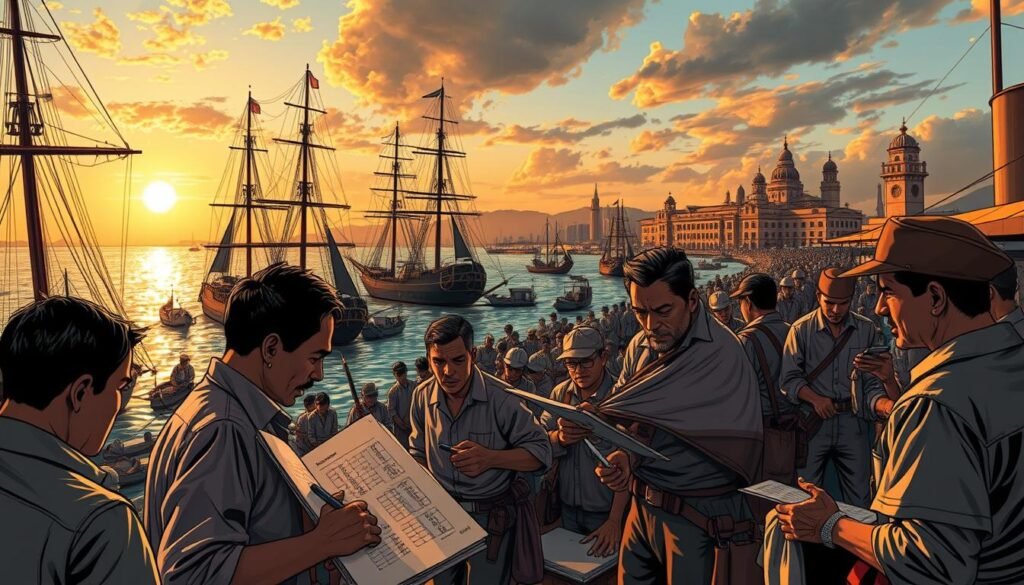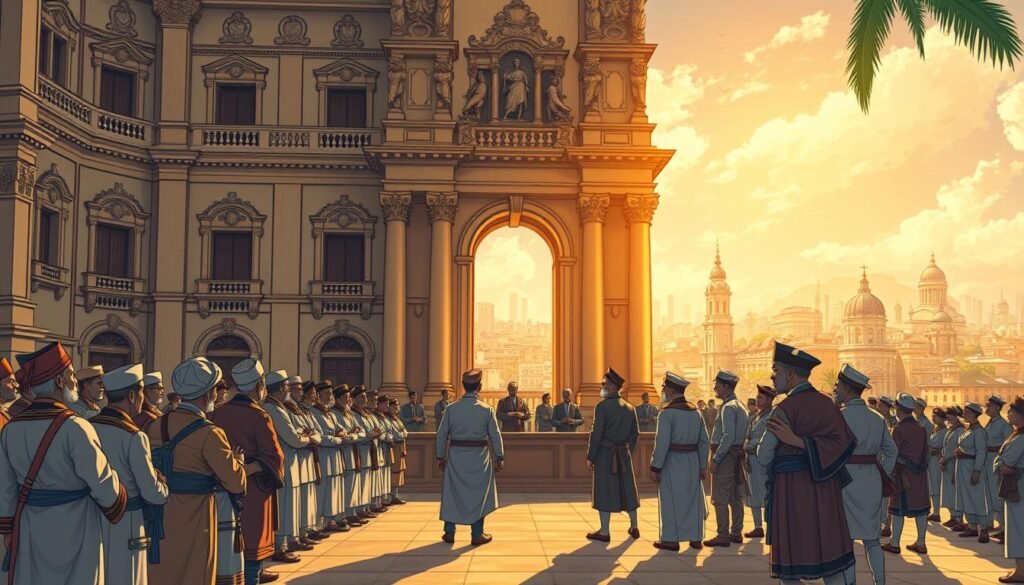Did you know that during the Spanish colonial period, local traders played a pivotal role in shaping the Philippines’ economy? By the late 16th century, they had become key players in the galleon trade, connecting Asia and the Americas. This era marked a significant shift in commerce, as these traders navigated complex economic and cultural landscapes.
Their activities were not without challenges. Legal disputes and maritime insurance cases often arose, reflecting the risks of long-distance trade. These cases provide a fascinating glimpse into the intersection of history and law, offering valuable insights for modern legal analysis.
Understanding this period is crucial for anyone interested in the evolution of trade, law, and cultural exchange. It highlights the resilience and adaptability of local traders in the face of colonial pressures.
Key Takeaways
- Local traders were central to the galleon trade during the Spanish era.
- They faced numerous legal and insurance challenges.
- Historical trade insights offer valuable lessons for modern legal studies.
- The Spanish colonial period shaped the Philippines’ economic landscape.
- Understanding this era provides a deeper appreciation of cultural and commercial history.
Historical Foundations of Spanish-Era Trade
Trade routes established in the Spanish era connected distant cultures and economies. The Manila Galleon Trade, operating from 1565 to 1815, became a cornerstone of global commerce. This route linked Asia and the Americas, transporting luxury goods like spices and fine porcelains in exchange for gold and silver.

Spanish economic policies played a significant role in shaping these trade networks. Regulations and fiscal measures were designed to maximize colonial profits. These policies influenced local traders, who navigated complex legal frameworks to thrive in this system.
Economic Policies and Global Trade Routes
The Spanish Crown implemented strict trade regulations to control the flow of goods. The galleon trade route, with stopovers in Guam and the Marianas, became a vital artery of commerce. By 1668, Guam was officially recognized as a key stop, further solidifying its role in the trade network.
Maritime policies also introduced early forms of insurance to mitigate risks. Shipwrecks, such as the San Pablo in 1568, highlighted the dangers of long-distance trade. These incidents led to the development of legal frameworks to address disputes and protect investments.
Cultural Influences Shaping Market Dynamics
Cultural exchanges during this period reshaped market dynamics. The intermarriage of local women with Spanish, Filipino, and Mexican men brought new customs and practices. These changes influenced trade goods, from food to woven items, creating a unique blend of cultural and economic interactions.
For example, the CHamoru people prepared specific goods like pickled capers for trade. These items became staples in marketplaces, reflecting the fusion of indigenous and colonial influences. Such exchanges laid the groundwork for understanding later legal disputes, including those involving court appeals and party claims.
To delve deeper into the economic impacts of this era, explore this detailed analysis.
Filipino Merchants: Catalysts in Economic Development
Economic development during the Spanish era was heavily influenced by the ingenuity of local traders. These individuals emerged as vital economic players, navigating complex colonial systems to drive commerce forward. Their entrepreneurial spirit and innovative trade practices laid the foundation for a thriving economy.

Several factors contributed to their early growth. They adapted to new trade routes, introduced unique goods, and built networks that connected distant markets. However, they also faced significant challenges. Regulatory constraints and competition from foreign traders often hindered their progress.
Emergence and Early Growth
Local traders quickly became central to the galleon trade, leveraging their knowledge of regional markets. They introduced goods like spices, textiles, and ceramics, which were highly sought after. This innovation not only boosted trade but also enriched cultural exchanges.
Despite their success, they encountered legal disputes that shaped modern trade practices. For example, cases involving defendants and petitioners highlighted the complexities of maritime insurance. These disputes often reached the trial court, setting precedents for future trade regulations.
One notable case involved an insurance company refusing to cover a lost shipment. The petition filed by the trader led to a landmark decision, emphasizing the importance of fair practices in commerce. Such cases underscore the dual nature of their contributions—economic innovation and legal influence.
Historical records reveal their resilience in the face of adversity. From navigating colonial policies to overcoming competition, their efforts left a lasting impact on both commerce and law. Their legacy continues to inspire modern traders and legal scholars alike.
Key Legal Cases and Court Decisions
Supreme Court decisions in the Spanish era influenced modern maritime law. These cases often revolved around disputes involving cargo damage and insurance claims. One notable example is the application of the “all risks” policy, which became a cornerstone in maritime insurance disputes.

In one landmark case, the respondent argued that the company failed to honor its “all risks” policy. The court examined the extent of the damage and the validity of the complaint. The ruling emphasized the importance of clear policy terms and fair practices in insurance agreements.
Breakdown of Supreme Court Decisions
The Supreme Court’s role in these cases was pivotal. Judges meticulously reviewed evidence, including survey findings and computations of claims. Their decisions often hinged on the interpretation of insurable interest and the responsibilities of the respondent.
For instance, in a case involving the merchants insurance co., the court ruled that the company was liable for the full extent of the damage. This decision reinforced the principle that insurers must adhere to the terms of their policies, even in complex maritime disputes.
Understanding ‘All Risks’ Policies in Maritime Disputes
The “all risks” policy was designed to provide comprehensive coverage for cargo. However, disputes arose when insurers denied claims based on ambiguous policy language. Courts often had to interpret these terms to determine liability.
In one case, the court ruled that the company must honor the policy unless it could prove the damage was caused by an excluded risk. This decision set a precedent for future cases, ensuring that insurers could not arbitrarily deny claims.
| Case | Key Issue | Outcome |
|---|---|---|
| Case A | Interpretation of “all risks” policy | Insurer held liable |
| Case B | Insurable interest dispute | Claim denied |
| Case C | Cargo damage assessment | Partial compensation awarded |
These cases highlight the evolving nature of maritime law. They also underscore the importance of clear policy language and fair judicial processes in resolving complex disputes.
Maritime Insurance Disputes and Their Implications
Maritime insurance disputes have long been a cornerstone of legal battles in global trade. These cases often involve complex issues, from cargo damage to policy interpretation. One notable example is the Filipino Merchants Insurance Co. case, which highlighted the challenges insurers face in resolving claims.

Insights from the Filipino Merchants Insurance Co. Case
The Filipino Merchants Insurance Co. case centered on a disputed claim involving cargo damage. The insurer argued that the policy did not cover the specific issue, while the claimant insisted on full compensation. The court examined the policy terms and the extent of the damage, ultimately ruling in favor of the claimant.
This case underscores the importance of clear policy language. As one legal expert noted,
“Ambiguity in insurance contracts often leads to prolonged disputes, emphasizing the need for precise wording.”
Third-Party Complaints Versus Main Actions
In maritime insurance, third-party complaints often complicate the main action. These complaints arise when a party not directly involved in the insurance contract files a claim. For example, a shipping company might file a complaint against an insurer for failing to cover cargo damage.
Distinguishing between third-party complaints and main actions is crucial. The former often involve additional legal issues, such as liability and jurisdiction. This distinction helps streamline the resolution process, ensuring that all parties receive fair treatment.
Interpreting the Carriage of Goods by Sea Act
The Carriage of Goods by Sea Act (COGSA) plays a pivotal role in maritime insurance disputes. This act governs the responsibilities of carriers and shippers, including liability for cargo loss or damage. In the Filipino Merchants Insurance Co. case, COGSA was used to determine the carrier’s liability.
Understanding COGSA is essential for resolving modern maritime disputes. As highlighted in this analysis, the act provides a framework for addressing complex legal issues in global trade.
| Case | Key Issue | Outcome |
|---|---|---|
| Filipino Merchants Insurance Co. | Policy ambiguity | Claimant won |
| Third-Party Complaint | Liability dispute | Case dismissed |
| COGSA Application | Carrier liability | Partial compensation |
These cases illustrate the evolving nature of maritime insurance disputes. They also highlight the need for clear legal frameworks and fair practices. For further insights, explore this detailed report on maritime enforcement challenges.
The Role of Court Appeals in Defining Merchant Liability
Court appeals have played a crucial role in shaping merchant liability in maritime trade. These legal processes often reaffirm or clarify decisions made by lower courts, providing a deeper understanding of the matter. For instance, in December 1976, a significant event involving cargo damage led to a landmark ruling that redefined the burden of proof in “all risks” policies.

Appellate courts meticulously review evidence, ensuring that lower court decisions align with legal principles. This process not only resolves disputes but also sets precedents that guide future cases. The g.r. decisions, in particular, have been instrumental in interpreting maritime law and merchant responsibilities.
Judicial Reasoning on Merchant Claims
Judicial reasoning in these cases often centers on the interpretation of policy terms and the extent of liability. For example, in one case, the court ruled that the insurance co. must honor the policy unless it could prove the damage was caused by an excluded risk. This decision emphasized the importance of clear policy language and fair practices.
Another fact highlighted in these cases is the burden of proof on the insured. Under an “all risks” policy, the insured must show that the cargo was in good condition when the policy attached and that it was damaged when unloaded. This principle has become a cornerstone in maritime insurance disputes.
Impact on Modern Legal Precedents
The appellate decisions have had a lasting impact on modern legal precedents. They have clarified the responsibilities of insurance co. and merchants, ensuring fair treatment in disputes. For instance, the December 1976 ruling set a precedent for handling cargo damage claims, influencing how similar cases are resolved today.
These decisions also highlight the importance of the g.r. process in guiding future interpretations of maritime law. By addressing complex legal matters, appellate courts have provided a framework for resolving disputes efficiently and fairly.
For further insights into the legal framework governing such cases, explore this detailed analysis on corporate liability and legal mechanisms.
Conclusion
The rise of local traders during the Spanish era left a lasting mark on trade and legal practices. Their resilience and adaptability shaped economic development, while their legal disputes set precedents for modern maritime insurance policies. Court rulings, particularly those involving “all risks” policies, clarified merchant liability and ensured fair practices in commerce.
Despite time limitations and legal barriers, these historical and legal developments continue to influence modern trade. The burden of proof in insurance claims, for example, remains a cornerstone of maritime law. This highlights the importance of clear policy language and judicial fairness.
Combining historical and legal perspectives provides a comprehensive understanding of this case study. It underscores the economic legacy of these traders and the judicial principles that guide today’s maritime disputes. For further insights into the global maritime industry, explore this detailed analysis.
FAQ
What role did economic policies play in Spanish-era trade?
Economic policies during the Spanish era shaped global trade routes, influencing how goods were exchanged and markets developed. These policies laid the groundwork for the rise of local traders.
How did cultural influences affect market dynamics in the Spanish era?
Cultural exchanges during this period introduced new practices and goods, blending local traditions with foreign elements. This fusion created unique market dynamics that supported economic growth.
What were the key factors in the early growth of Filipino traders?
The early growth of traders was driven by access to global trade routes, local resource availability, and the ability to adapt to changing economic demands.
How did Supreme Court decisions impact maritime insurance disputes?
Supreme Court rulings clarified the interpretation of ‘all risks’ policies, setting precedents for resolving disputes related to cargo damage and liability in maritime trade.
What was the significance of the Filipino Merchants Insurance Co. case?
This case highlighted the complexities of maritime insurance, particularly in addressing third-party complaints and interpreting the Carriage of Goods by Sea Act.
How do court appeals define merchant liability in modern cases?
Court appeals often refine legal interpretations, establishing guidelines for merchant liability that influence contemporary legal precedents and dispute resolutions.
Source Links
- Philippines – Spanish Colonization, Culture, Trade | Britannica
- History of the Philippines (1565–1898)
- Manila Galleon Trade Route-La Nao de China: A Legacy in the Marianas – Guampedia
- Economic history of the Philippines
- Maritime Trade in the Philippines During the 15th Century CE
- Exploring the Philippines’ Latest Economic Reforms
- ADB to Support Philippine Local Governance Reforms with $300 Million Loan
- Significant Supreme Court Decisions in 2023 – Supreme Court of the Philippines
- Decisions – Supreme Court of the Philippines
- Shipping 2024 – Philippines | Global Practice Guides
- Insurance & Reinsurance Laws and Regulations Report 2024-2025 Philippines
- G.R. No. 85141
- G.R. No. 189626 – GREGORIO AMOGUIS TITO AMOGUIS, PETITIONERS, VS. CONCEPCION BALLADO AND MARY GRACE BALLADO LEDESMA, AND ST. JOSEPH REALTY, LTD. RESPONDENTS.DECISION
- Insurance Case Digest: Filipino Merchants Insurance Co. v. CA (1989)
- G.R. No. L-54140 October 14, 1986

